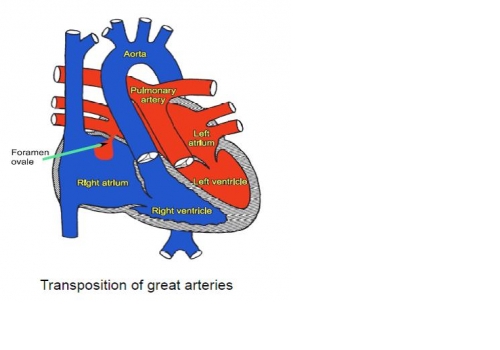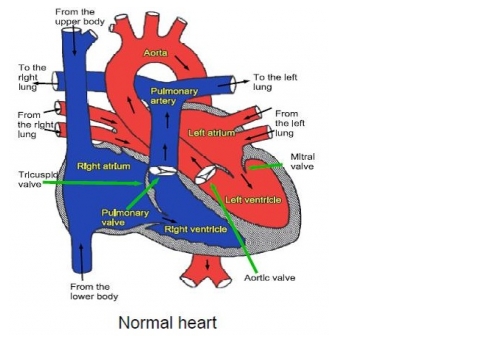Teen
- About
- Meet The Team
- Conditions
- Aortic Stenosis
- Atrial Septal Defect
- Coarctation of the Aorta
- Complete Atrioventricular Septal Defect
- Interrupted Aortic Arch
- Normal Heart
- Partial Atrio-Ventricular Septal Defect
- Patent Ductus Arteriosus
- Pulmonary Atresia with Intact Ventricular Septum
- Pulmonary Atresia with Ventricular Septal Defect
- Pulmonary Stenosis
- Small Ventricular Septal Defect (Muscular)
- Small Ventricular Septal Defect (Perimembraneous)
- Tetralogy of Fallot
- Transposition of the Great Arteries
- Ventricular Septal Defect (Large)
- Transition to Adult Congenital Cardiac Services
- Coming in to Hospital
- Surgery and Managing Your Discomfort
- Cardiac Catheter
- Ablation Procedure
- Pacemakers
- Looking after your oral health
- Lifestyle and Exercise Advice
- Periods, contraception and pregnancy
- Support
- Your Views
- Confidentiality and Consent
Transposition of the Great Arteries
This is a serious heart condition in which the main artery which should arise from the right side of the heart comes from the left side, and the artery which should arise from the left side of the heart comes from the right side.
In the normal circulation blue blood, in which the oxygen has been used up by the body, drains to the right side of the heart which pumps the blood to the lungs. In the lungs oxygen is collected, making the blood pink (or “oxygenated”). The pink blood is then returned to the left side of the heart which pumps the pink blood to the body. In a baby with transposition the blue blood gets pumped back to the body instead of to the lungs, the baby appears blue shortly after birth and may die quickly without treatment.


Tests
Usually an ultrasound scan (“echo”) is required to make the diagnosis.
Treatment
The first stage of treatment is to try to keep the baby alive by increasing the amount of oxygenated blood which gets to the body. Medicines can help to some extent and most babies will be given a drug called prostin, as an injection into one of their veins. Almost all babies with transposition will also need a procedure called a “balloon septostomy” to make sure they get enough oxygen to their body to survive. This involves putting a tube with a small balloon at its tip into the vein at the top of the leg or in the umbilicus. The tube is passed up into the heart and across the flap of heart tissue which separates the two small filling chambers, using an ultrasound scan to see it is in the correct position. The balloon is then blown up and the catheter is pulled back across the flap, tearing a hole in it and allowing oxygenated blood to cross from the left side of the heart to the right side.
Once the baby is safe, we can plan the baby’s operation to “switch” the arteries. The switch is usually done within the first two weeks after birth. Most babies are well enough to go home 5-7 days after the operation.
Risks of treatment
Balloon septostomy is usually safe, but there is a very small risk (about 1 in 200) of serious complications such as heart rhythm abnormalities or even death. Although the switch operation is a very major one, the risk to the baby is small – about 1 out of 100 babies will die at operation and about 1 out of 100 may have other, potentially very serious complications such as brain damage (sometimes permanent), kidney damage or serious heart rhythm abnormalities. There is also a risk of respiratory infections or fluid collecting around the lungs after surgery, both complications
which usually respond to treatment but may mean the baby staying longer in hospital.
Complications can sometimes occur late – even many years after a successful switch operation, and it is important to have occasional but regular visits to the outpatient clinic to make sure all is well as the baby grows and even throughout adult life too. Late problems which can arise include narrowing of the artery leading to the lungs (the pulmonary artery), leaking heart valves (most commonly the aortic valve), and narrowings of the small arteries (the coronary arteries) which feed blood to the heart muscle. These complications are all rare but can be serious enough to need further surgery.
General advice for the future
Most patients lead a normal active life after a switch operation, including sports. If there are any particularly strenuous activities to be avoided your cardiologist will tell you.
All patients who have had a switch operation will be at risk of infection in the heart (called endocarditis) after surgery. Such infections may be caused by infections of the teeth or gums. It is important to visit the dentist regularly and to remind the dentist at each visit of the heart abnormality. Ear or body piercing and tattooing are best avoided as they also carry a small risk of infection which may spread to the heart.
